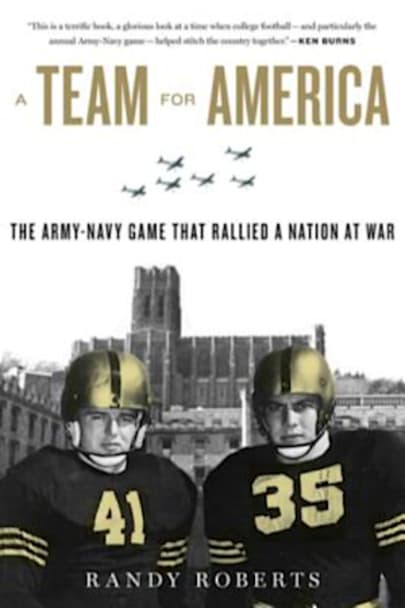“A rousing celebration of a moment in history when college football was more than metaphor and entertainment, it was a gritty sidebar to real war.” — Robert Lipsyte, author of An Accidental Sportswriter Each year the Army and Navy football teams meet for one epic game. Across the nation, fans tune in to see who will emerge victorious. But no game will ever match the one that was played on … was played on December 2, 1944. America was in the midst of World War II: soldiers and sailors were dying around the globe, and the home front suffered through shortages. But for one day, all that was forgotten.
Navy’s team was ranked number two, Army’s number one and on the verge of becoming national champions. Everywhere, the war stopped as soldiers listened to the broadcast. Randy Roberts has interviewed the surviving players and coaches, bringing their stories to life. For three years, military upperclassmen graduated and joined the fight. For three hours, their alma mater gave them back one unforgettable performance.
“The story of Army’s celebrated 1944 national championship team is a fascinating one, and its victory over Navy that year is remembered as one of college football’s greatest games. But Randy Roberts’s A Team for America tells an even greater story. It is a story of our country. Of a time when college football — and this remarkable Army team — helped rekindle hope and confidence throughout the land.” — Brigadier General Peter M. Dawkins, U.S. Army (Ret.), 1958 Heisman Trophy winner, West Point
“Roberts brings a historian’s thoroughness to the subject . . . A fascinating time in American collegiate sports history.” — Kirkus Reviews
more



Dec. 12 marked the 121st game between Army and Navy on the gridiron. They have met every year since 1890, apart from two separate two-year breaks during World War I and in the late 1920s. This year they will play at West Point, in spite of the global pandemic. Even at the height of World War II, the game was played. The game on Dec. 2, 1944, will go down as one of the most momentous college football games ever to take place. No. 1 Army vs. No. 2 Navy. Army was undefeated and untied. Both teams had beaten perennial power Notre Dame. U.S. troops who were fighting across the globe in Europe and in the Pacific, took a short break to listen in on what was billed as the “Game of the Century.” It was the Super Bowl, the World Series, the Kentucky Derby, and the Indianapolis 500 all rolled into one event. The teams met at Memorial Stadium in Baltimore. The game captured the nation’s full attention during the grim moths of late 1944 as American casualties mounted overseas. So integral was this game to the nation’s war effort that spectators purchased more than $58 million in war bonds. Army, led by back-to-back Heisman Trophy winners Doc Blanchard and Glenn Davis (“Mr. Inside and Mr. Outside”), claimed the national championship with a tough 23-7 victory. Undefeated Army would repeat this feat the following year and take home a third national championship after beating an undefeated no. 2 ranked Navy team. No sporting event will perhaps ever capture the full rapt attention of the American nation as the Army-Navy game that was played in 1944.
The build-up to the game and the subsequent gridiron tussle are eloquently portrayed by Randy Roberts in his fine book “A Team for America.” Roberts profiles the main characters, choosing to focus on the Army team and players, such as Blanchard and Davis, as well as the Army coach Earl “Red” Blaik, the first man to coach the team that was not a serving officer. A mere two weeks after the game, a German offense in the Ardennes stopped cold the Allied advance in Europe. Two months after the game, U.S. Marines landed on Iwo Jima and incurred the single deadliest day in the history of the Marine Corps. The American public settled back into the grim routine of a world war, as 1945 proved to be the costliest year in the war for the United States. Some of the men playing that day would be thrust into the fire months after the game. But on the clear, cold afternoon of Dec. 2, 1944, the American public was able to forget about the war for three hours, and revel in watching (and listening to) two of the greatest teams in college football history to face off. Hopefully, tomorrow we can briefly forget about the terrible news of the losses in our current pandemic and focus on two tremendous teams of young men who will go off to serve their country wherever duty takes them.